
December 2020 Larimar Therapeutics Corporate Presentation Exhibit 99.1
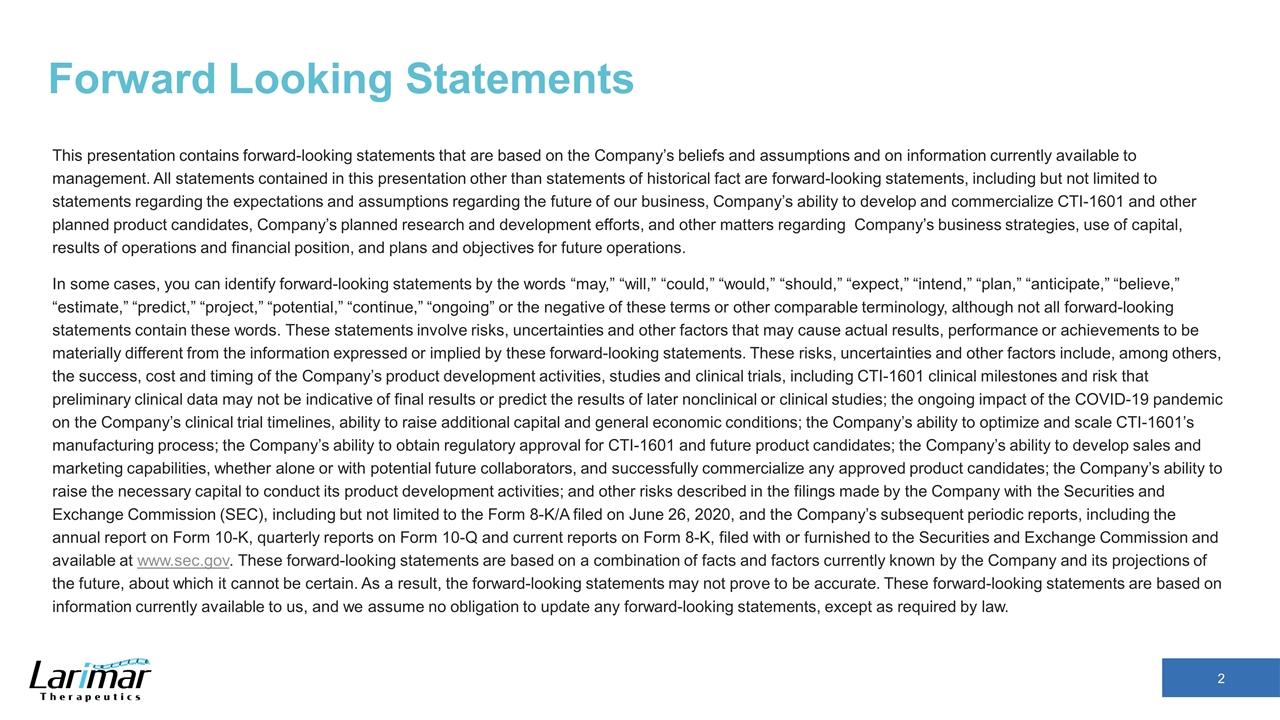
Forward Looking Statements This presentation contains forward-looking statements that are based on the Company’s beliefs and assumptions and on information currently available to management. All statements contained in this presentation other than statements of historical fact are forward-looking statements, including but not limited to statements regarding the expectations and assumptions regarding the future of our business, Company’s ability to develop and commercialize CTI-1601 and other planned product candidates, Company’s planned research and development efforts, and other matters regarding Company’s business strategies, use of capital, results of operations and financial position, and plans and objectives for future operations. In some cases, you can identify forward-looking statements by the words “may,” “will,” “could,” “would,” “should,” “expect,” “intend,” “plan,” “anticipate,” “believe,” “estimate,” “predict,” “project,” “potential,” “continue,” “ongoing” or the negative of these terms or other comparable terminology, although not all forward-looking statements contain these words. These statements involve risks, uncertainties and other factors that may cause actual results, performance or achievements to be materially different from the information expressed or implied by these forward-looking statements. These risks, uncertainties and other factors include, among others, the success, cost and timing of the Company’s product development activities, studies and clinical trials, including CTI-1601 clinical milestones and risk that preliminary clinical data may not be indicative of final results or predict the results of later nonclinical or clinical studies; the ongoing impact of the COVID-19 pandemic on the Company’s clinical trial timelines, ability to raise additional capital and general economic conditions; the Company’s ability to optimize and scale CTI-1601’s manufacturing process; the Company’s ability to obtain regulatory approval for CTI-1601 and future product candidates; the Company’s ability to develop sales and marketing capabilities, whether alone or with potential future collaborators, and successfully commercialize any approved product candidates; the Company’s ability to raise the necessary capital to conduct its product development activities; and other risks described in the filings made by the Company with the Securities and Exchange Commission (SEC), including but not limited to the Form 8-K/A filed on June 26, 2020, and the Company’s subsequent periodic reports, including the annual report on Form 10-K, quarterly reports on Form 10-Q and current reports on Form 8-K, filed with or furnished to the Securities and Exchange Commission and available at www.sec.gov. These forward-looking statements are based on a combination of facts and factors currently known by the Company and its projections of the future, about which it cannot be certain. As a result, the forward-looking statements may not prove to be accurate. These forward-looking statements are based on information currently available to us, and we assume no obligation to update any forward-looking statements, except as required by law.
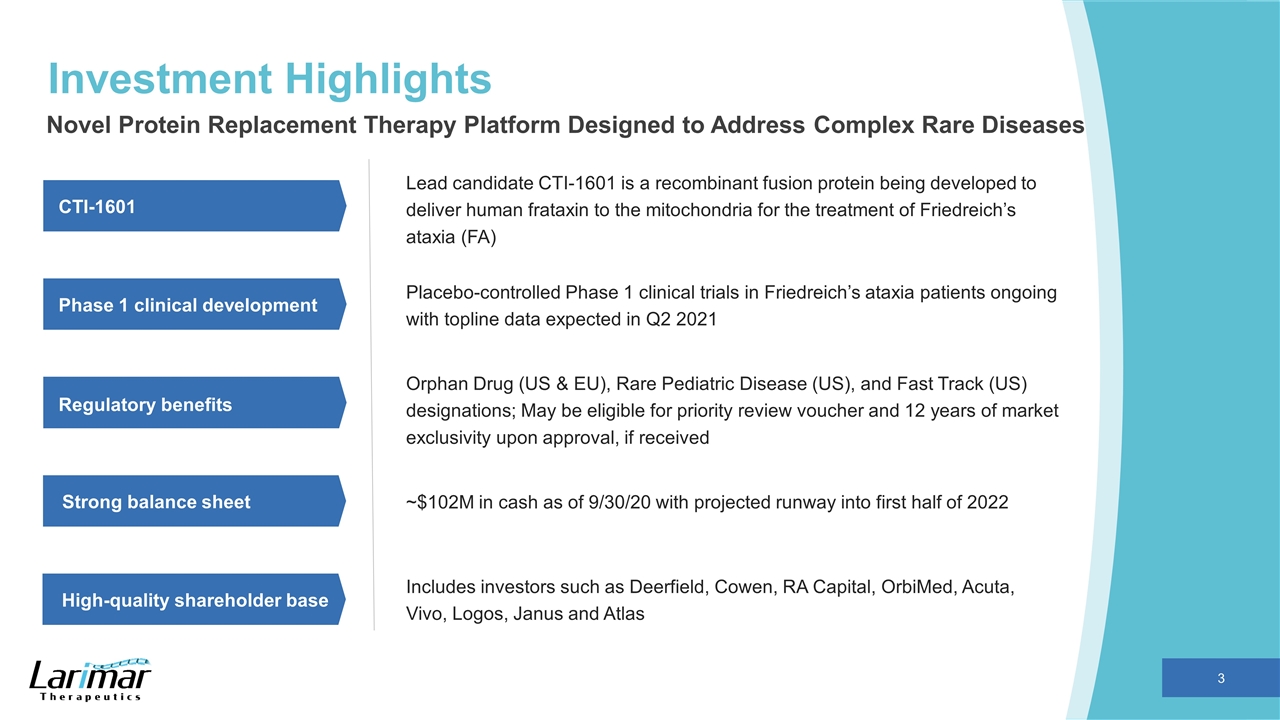
Lead candidate CTI-1601 is a recombinant fusion protein being developed to deliver human frataxin to the mitochondria for the treatment of Friedreich’s ataxia (FA) Investment Highlights Regulatory benefits Strong balance sheet Placebo-controlled Phase 1 clinical trials in Friedreich’s ataxia patients ongoing with topline data expected in Q2 2021 Orphan Drug (US & EU), Rare Pediatric Disease (US), and Fast Track (US) designations; May be eligible for priority review voucher and 12 years of market exclusivity upon approval, if received ~$102M in cash as of 9/30/20 with projected runway into first half of 2022 Phase 1 clinical development CTI-1601 Novel Protein Replacement Therapy Platform Designed to Address Complex Rare Diseases High-quality shareholder base Includes investors such as Deerfield, Cowen, RA Capital, OrbiMed, Acuta, Vivo, Logos, Janus and Atlas

Scientific Advisory Board Giovanni Manfredi, MD, PhD Finbar and Marianne Kenny Professor in Clinical and Research Neurology at Weill Cornell Medicine. Professor of Neuroscience at Weill Cornell Medicine. Russell Clayton, DO (Chairman) Former Chief Medical Officer at Alcresta Therapeutics, a medical device company Former Senior Vice President of Research and Development at Discovery Labs, a pharmaceutical and medical device company Co-founder of Chondrial Therapeutics, which became Larimar Therapeutics, Inc. Professor of Pediatrics at Indiana University School of Medicine Chief of the Division of Genetics and Metabolism, Director of the Rare Disease Institute, and Margaret O'Malley Chair of Genetic Medicine at Children’s National Hospital Executive Director of the Mitochondrial Medicine Frontier Program at The Children’s Hospital of Philadelphia (CHOP) Professor in the Division of Human Genetics, Department of Pediatrics at University of Pennsylvania Perelman School of Medicine Mark Payne, MD Marshall Summar, MD Marni J. Falk, MD
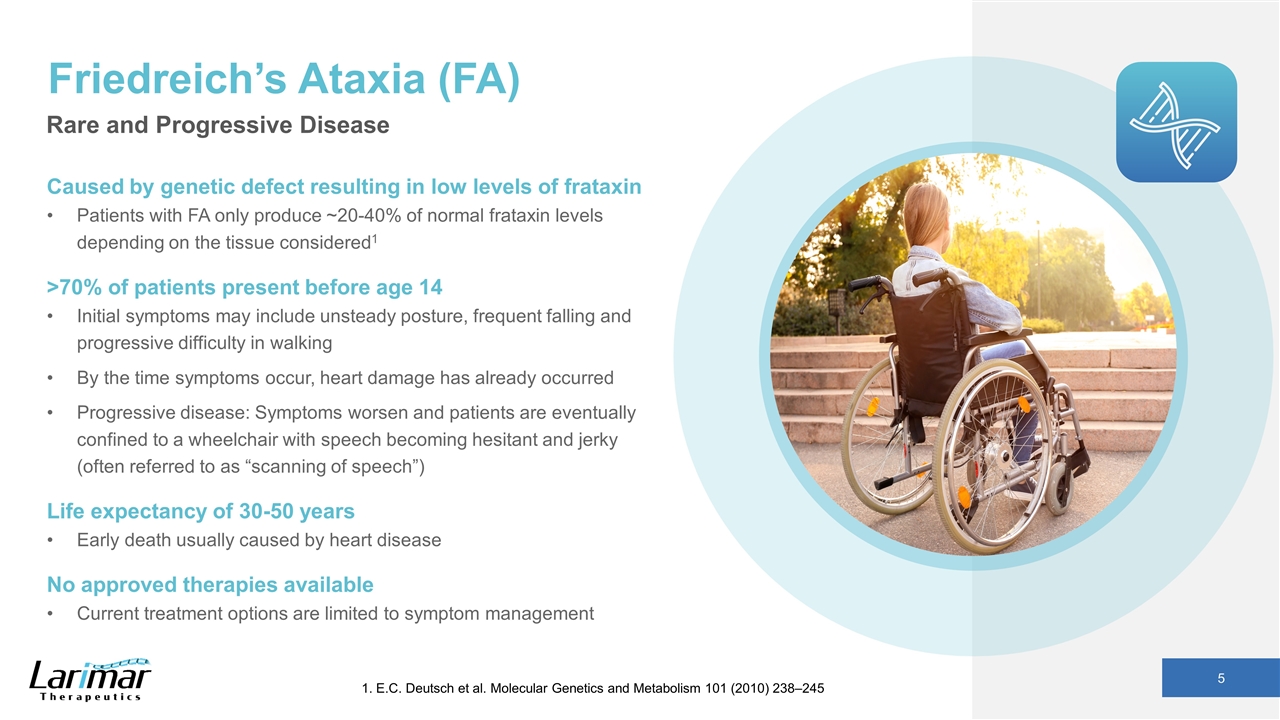
Caused by genetic defect resulting in low levels of frataxin Patients with FA only produce ~20-40% of normal frataxin levels depending on the tissue considered1 >70% of patients present before age 14 Initial symptoms may include unsteady posture, frequent falling and progressive difficulty in walking By the time symptoms occur, heart damage has already occurred Progressive disease: Symptoms worsen and patients are eventually confined to a wheelchair with speech becoming hesitant and jerky (often referred to as “scanning of speech”) Life expectancy of 30-50 years Early death usually caused by heart disease No approved therapies available Current treatment options are limited to symptom management Friedreich’s Ataxia (FA) Rare and Progressive Disease 1. E.C. Deutsch et al. Molecular Genetics and Metabolism 101 (2010) 238–245
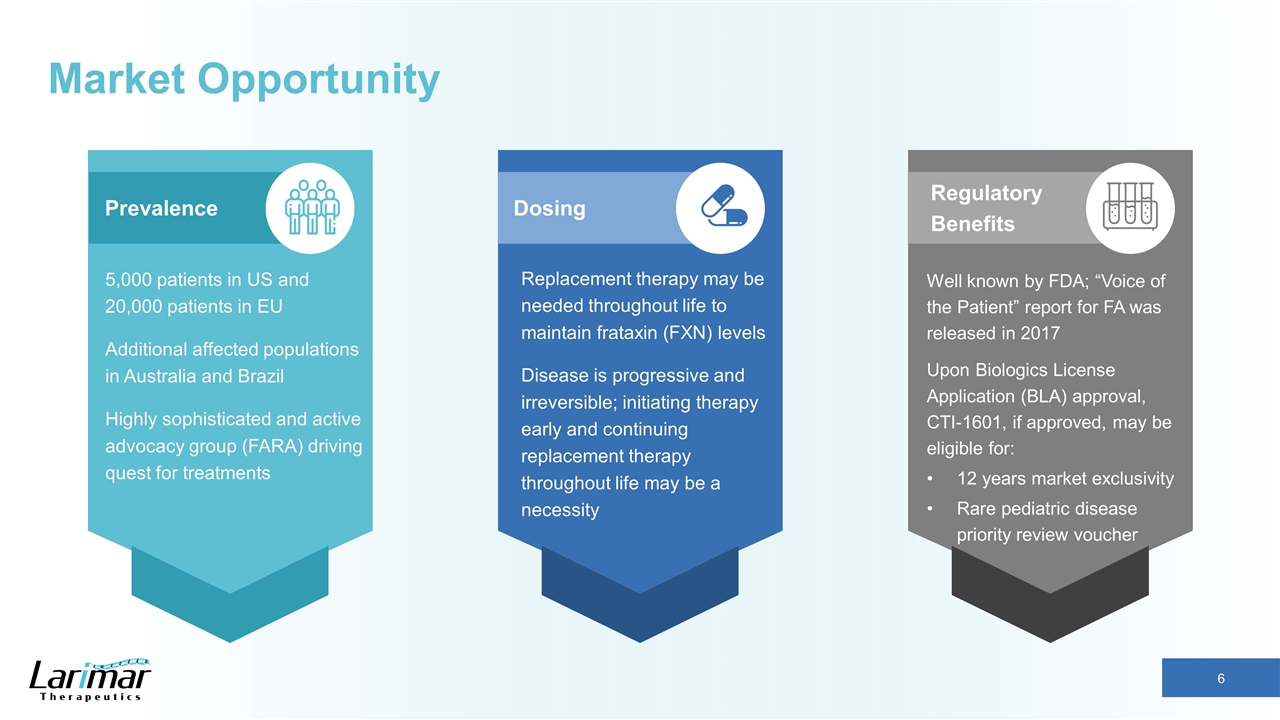
Market Opportunity Dosing Dosing Replacement therapy may be needed throughout life to maintain frataxin (FXN) levels Disease is progressive and irreversible; initiating therapy early and continuing replacement therapy throughout life may be a necessity Dosing Prevalence 5,000 patients in US and 20,000 patients in EU Additional affected populations in Australia and Brazil Highly sophisticated and active advocacy group (FARA) driving quest for treatments Dosing Regulatory Benefits Well known by FDA; “Voice of the Patient” report for FA was released in 2017 Upon Biologics License Application (BLA) approval, CTI-1601, if approved, may be eligible for: 12 years market exclusivity Rare pediatric disease priority review voucher
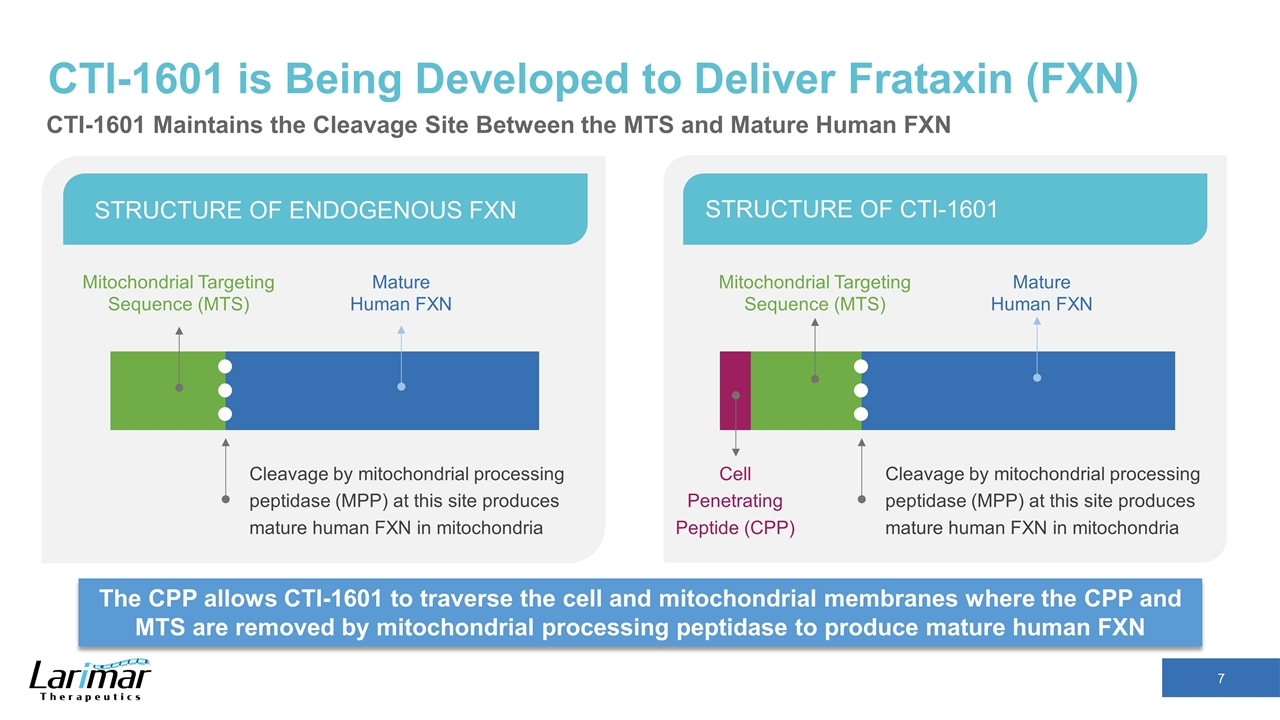
CTI-1601 is Being Developed to Deliver Frataxin (FXN) The CPP allows CTI-1601 to traverse the cell and mitochondrial membranes where the CPP and MTS are removed by mitochondrial processing peptidase to produce mature human FXN STRUCTURE OF ENDOGENOUS FXN STRUCTURE OF CTI-1601 Cleavage by mitochondrial processing peptidase (MPP) at this site produces mature human FXN in mitochondria Mitochondrial Targeting Sequence (MTS) Mature Human FXN Cleavage by mitochondrial processing peptidase (MPP) at this site produces mature human FXN in mitochondria Mature Human FXN Cell Penetrating Peptide (CPP) Mitochondrial Targeting Sequence (MTS) CTI-1601 Maintains the Cleavage Site Between the MTS and Mature Human FXN
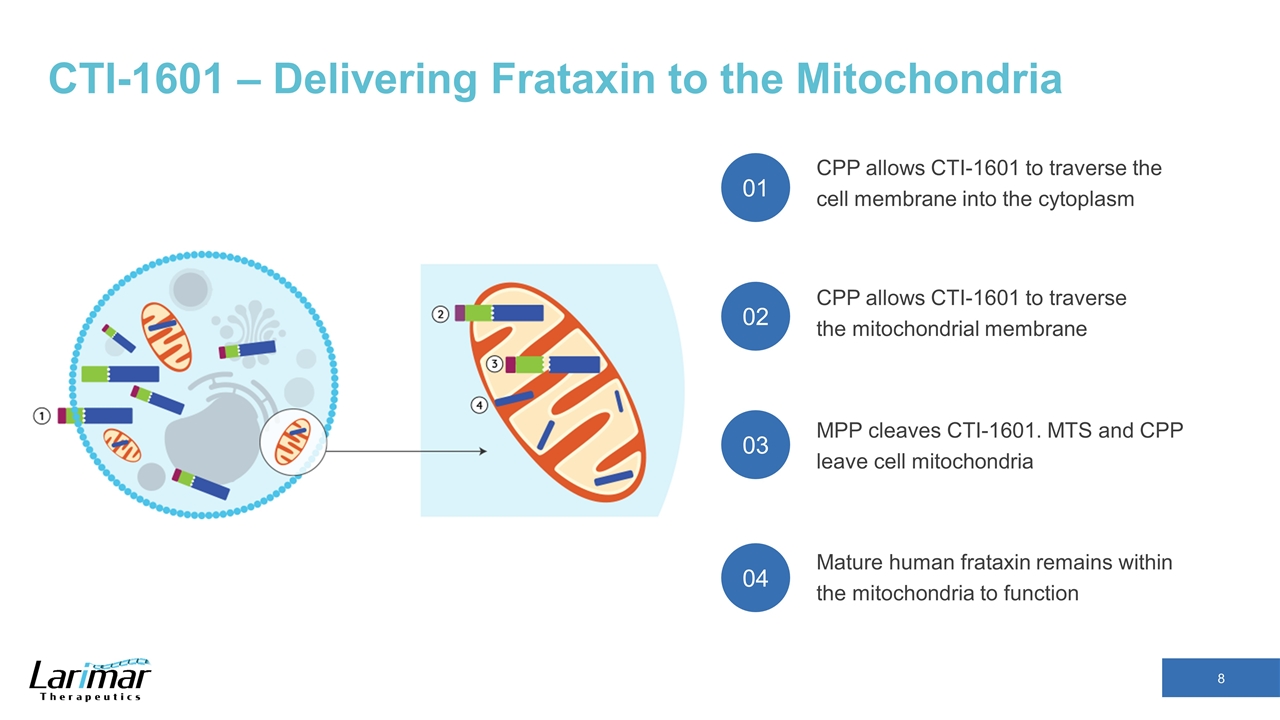
CTI-1601 – Delivering Frataxin to the Mitochondria 01 02 03 04 Mature human frataxin remains within the mitochondria to function MPP cleaves CTI-1601. MTS and CPP leave cell mitochondria CPP allows CTI-1601 to traverse the mitochondrial membrane CPP allows CTI-1601 to traverse the cell membrane into the cytoplasm
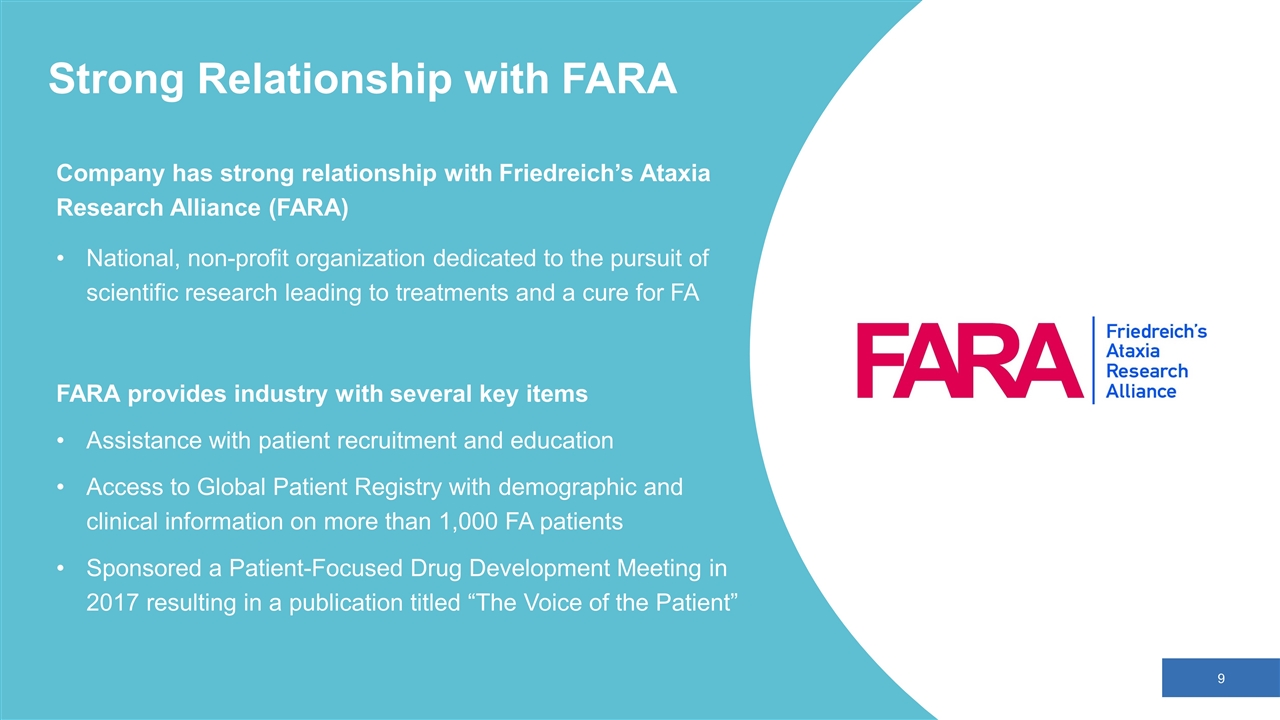
Company has strong relationship with Friedreich’s Ataxia Research Alliance (FARA) National, non-profit organization dedicated to the pursuit of scientific research leading to treatments and a cure for FA FARA provides industry with several key items Assistance with patient recruitment and education Access to Global Patient Registry with demographic and clinical information on more than 1,000 FA patients Sponsored a Patient-Focused Drug Development Meeting in 2017 resulting in a publication titled “The Voice of the Patient” Strong Relationship with FARA
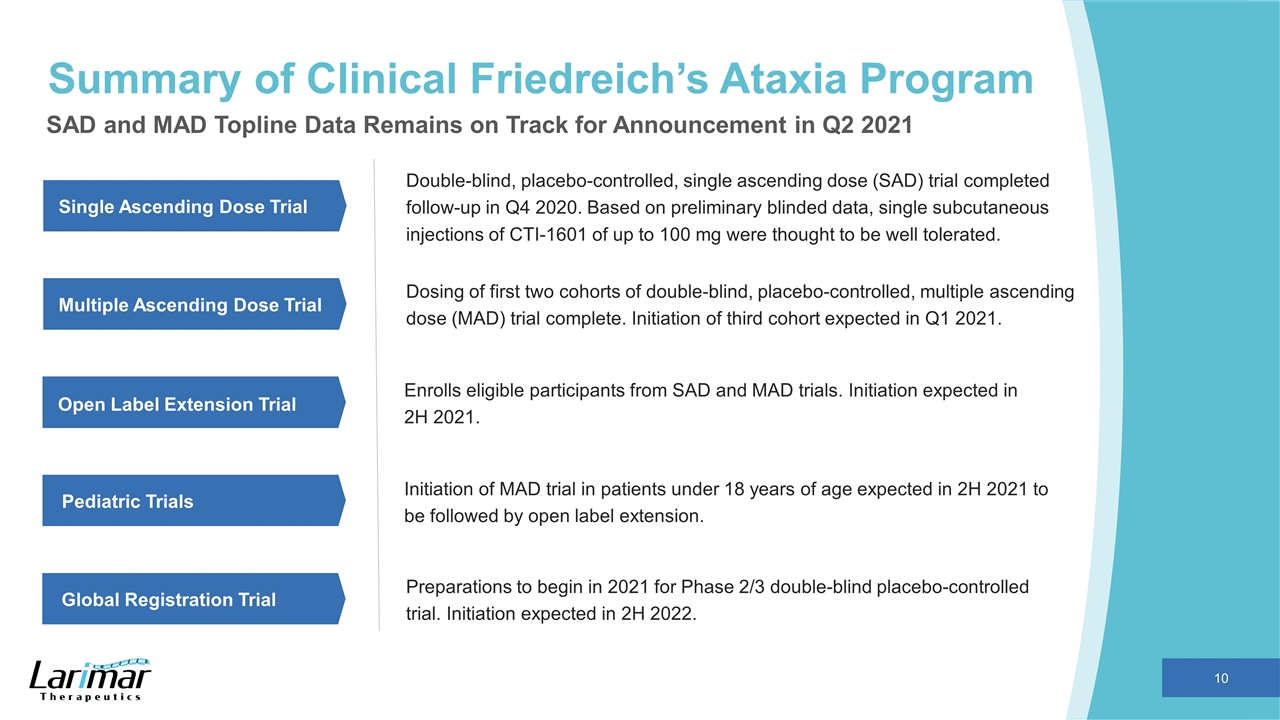
Double-blind, placebo-controlled, single ascending dose (SAD) trial completed follow-up in Q4 2020. Based on preliminary blinded data, single subcutaneous injections of CTI-1601 of up to 100 mg were thought to be well tolerated. Summary of Clinical Friedreich’s Ataxia Program Open Label Extension Trial Dosing of first two cohorts of double-blind, placebo-controlled, multiple ascending dose (MAD) trial complete. Initiation of third cohort expected in Q1 2021. Enrolls eligible participants from SAD and MAD trials. Initiation expected in 2H 2021. Initiation of MAD trial in patients under 18 years of age expected in 2H 2021 to be followed by open label extension. Multiple Ascending Dose Trial Single Ascending Dose Trial Pediatric Trials Preparations to begin in 2021 for Phase 2/3 double-blind placebo-controlled trial. Initiation expected in 2H 2022. Global Registration Trial SAD and MAD Topline Data Remains on Track for Announcement in Q2 2021
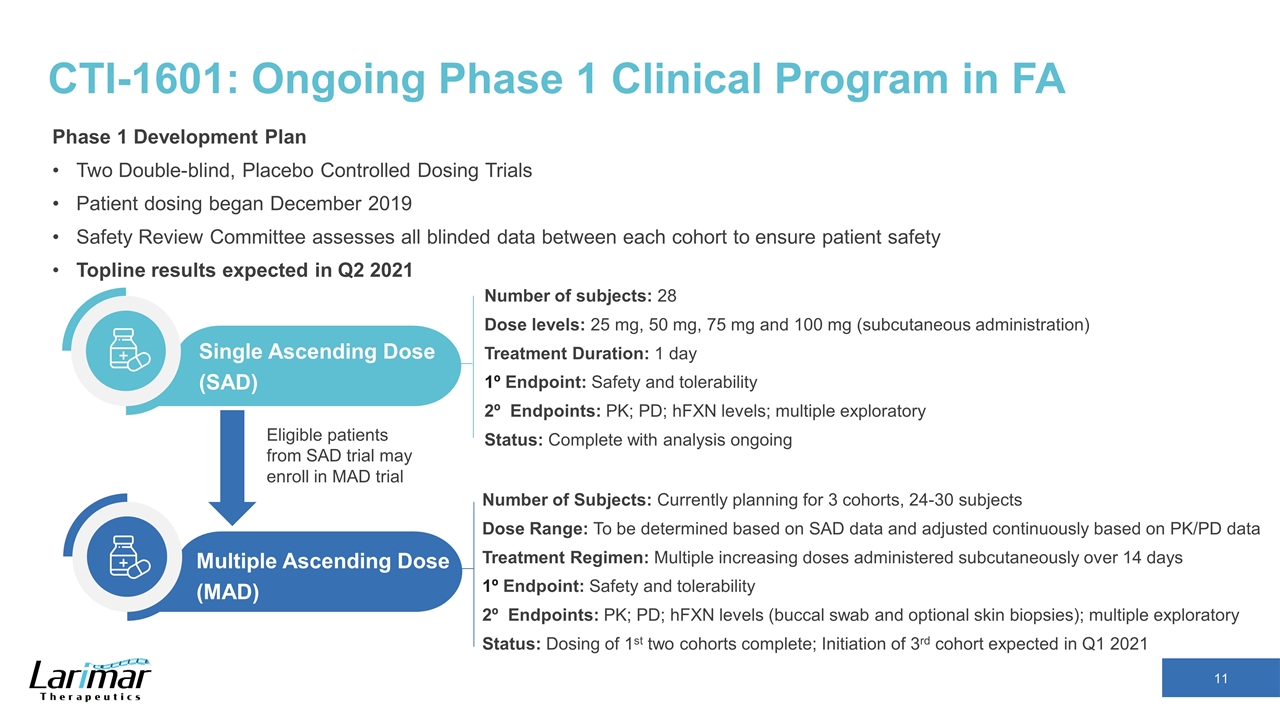
CTI-1601: Ongoing Phase 1 Clinical Program in FA Phase 1 Development Plan Two Double-blind, Placebo Controlled Dosing Trials Patient dosing began December 2019 Safety Review Committee assesses all blinded data between each cohort to ensure patient safety Topline results expected in Q2 2021 Number of subjects: 28 Dose levels: 25 mg, 50 mg, 75 mg and 100 mg (subcutaneous administration) Treatment Duration: 1 day 1º Endpoint: Safety and tolerability 2º Endpoints: PK; PD; hFXN levels; multiple exploratory Status: Complete with analysis ongoing Single Ascending Dose (SAD) Number of Subjects: Currently planning for 3 cohorts, 24-30 subjects Dose Range: To be determined based on SAD data and adjusted continuously based on PK/PD data Treatment Regimen: Multiple increasing doses administered subcutaneously over 14 days 1º Endpoint: Safety and tolerability 2º Endpoints: PK; PD; hFXN levels (buccal swab and optional skin biopsies); multiple exploratory Status: Dosing of 1st two cohorts complete; Initiation of 3rd cohort expected in Q1 2021 Multiple Ascending Dose (MAD) Eligible patients from SAD trial may enroll in MAD trial
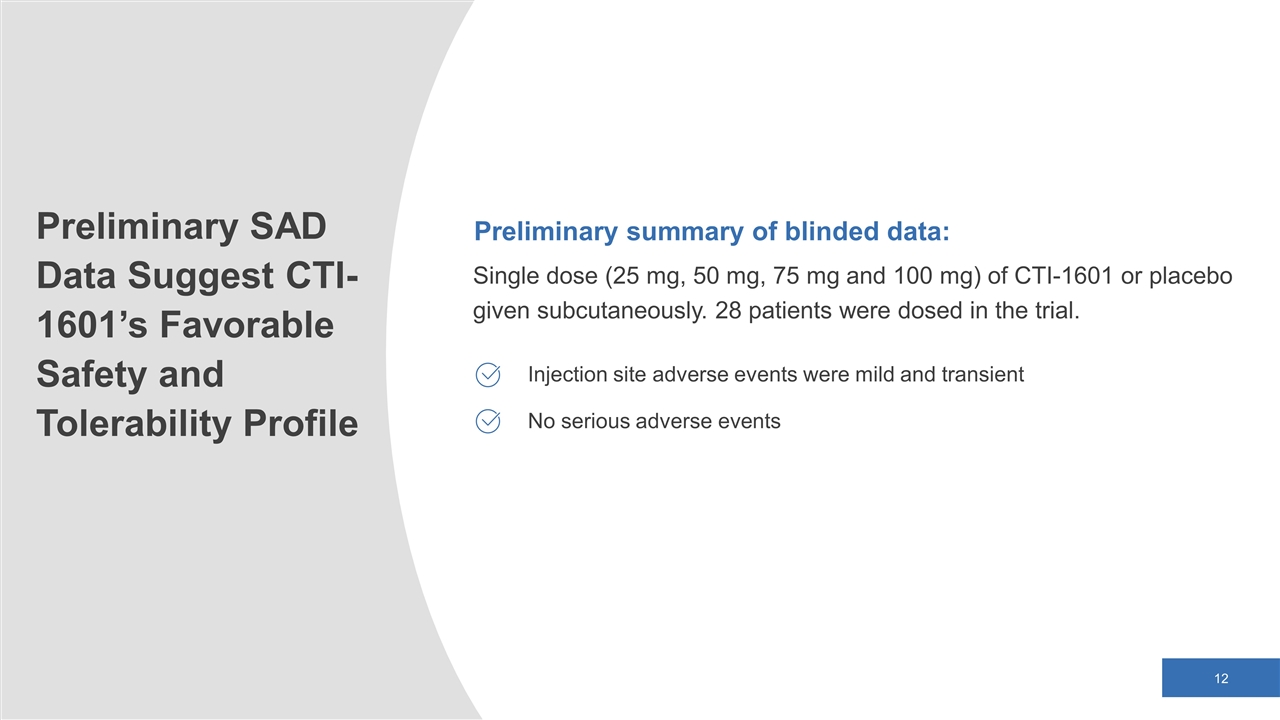
Preliminary summary of blinded data: Single dose (25 mg, 50 mg, 75 mg and 100 mg) of CTI-1601 or placebo given subcutaneously. 28 patients were dosed in the trial. Injection site adverse events were mild and transient No serious adverse events Preliminary SAD Data Suggest CTI-1601’s Favorable Safety and Tolerability Profile
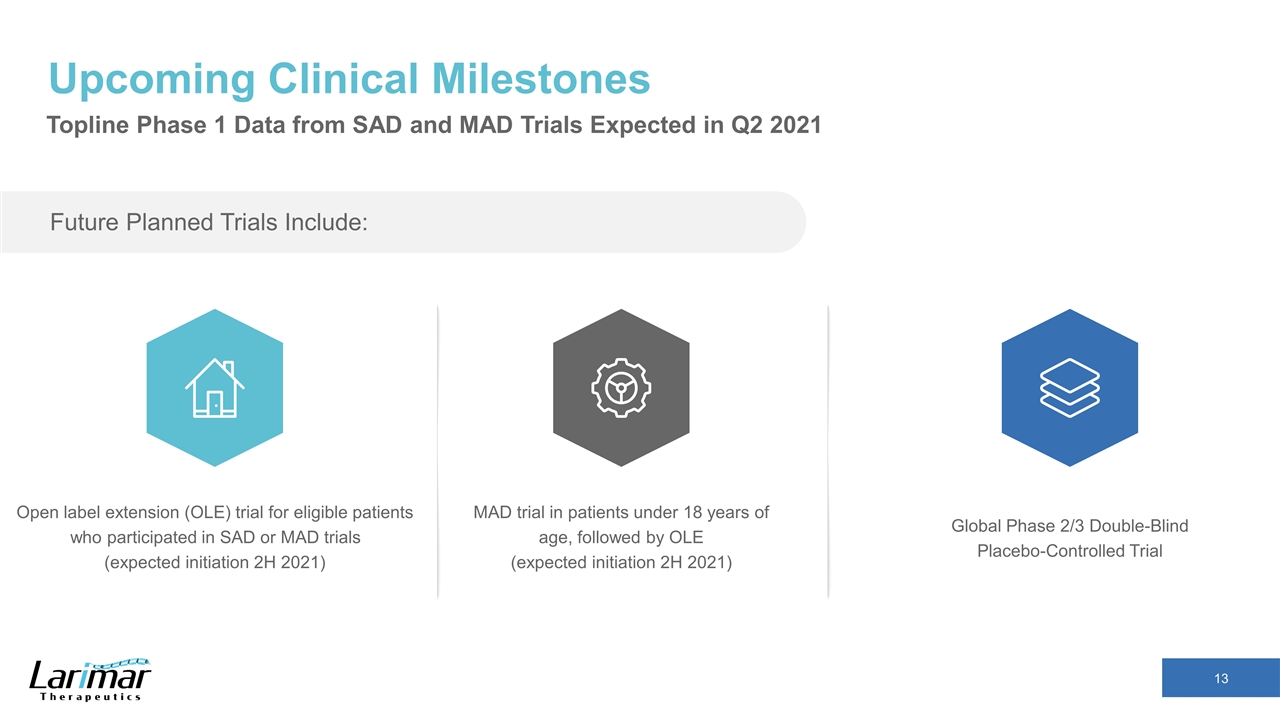
Upcoming Clinical Milestones Open label extension (OLE) trial for eligible patients who participated in SAD or MAD trials (expected initiation 2H 2021) MAD trial in patients under 18 years of age, followed by OLE (expected initiation 2H 2021) Global Phase 2/3 Double-Blind Placebo-Controlled Trial Future Planned Trials Include: Topline Phase 1 Data from SAD and MAD Trials Expected in Q2 2021
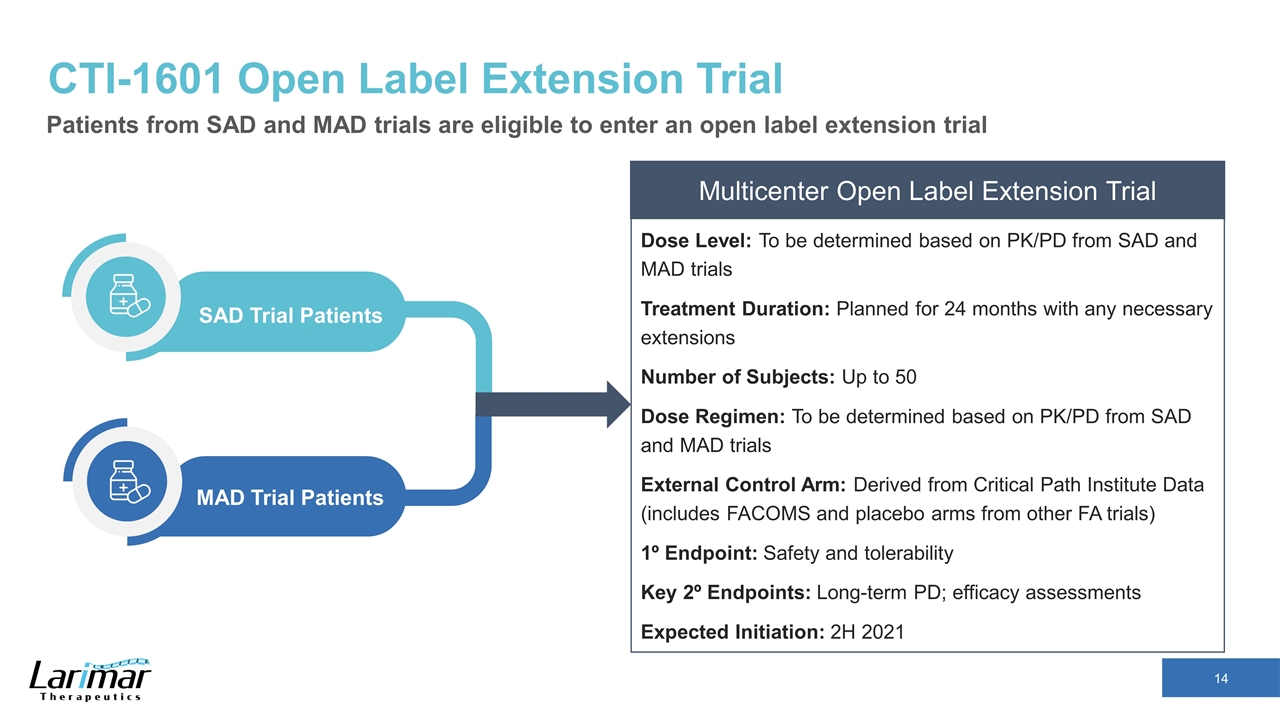
Dose Level: To be determined based on PK/PD from SAD and MAD trials Treatment Duration: Planned for 24 months with any necessary extensions Number of Subjects: Up to 50 Dose Regimen: To be determined based on PK/PD from SAD and MAD trials External Control Arm: Derived from Critical Path Institute Data (includes FACOMS and placebo arms from other FA trials) 1º Endpoint: Safety and tolerability Key 2º Endpoints: Long-term PD; efficacy assessments Expected Initiation: 2H 2021 CTI-1601 Open Label Extension Trial Patients eligible to enroll from Phase 1/Pediatric Patients from SAD and MAD trials are eligible to enter an open label extension trial SAD Trial Patients MAD Trial Patients Multicenter Open Label Extension Trial
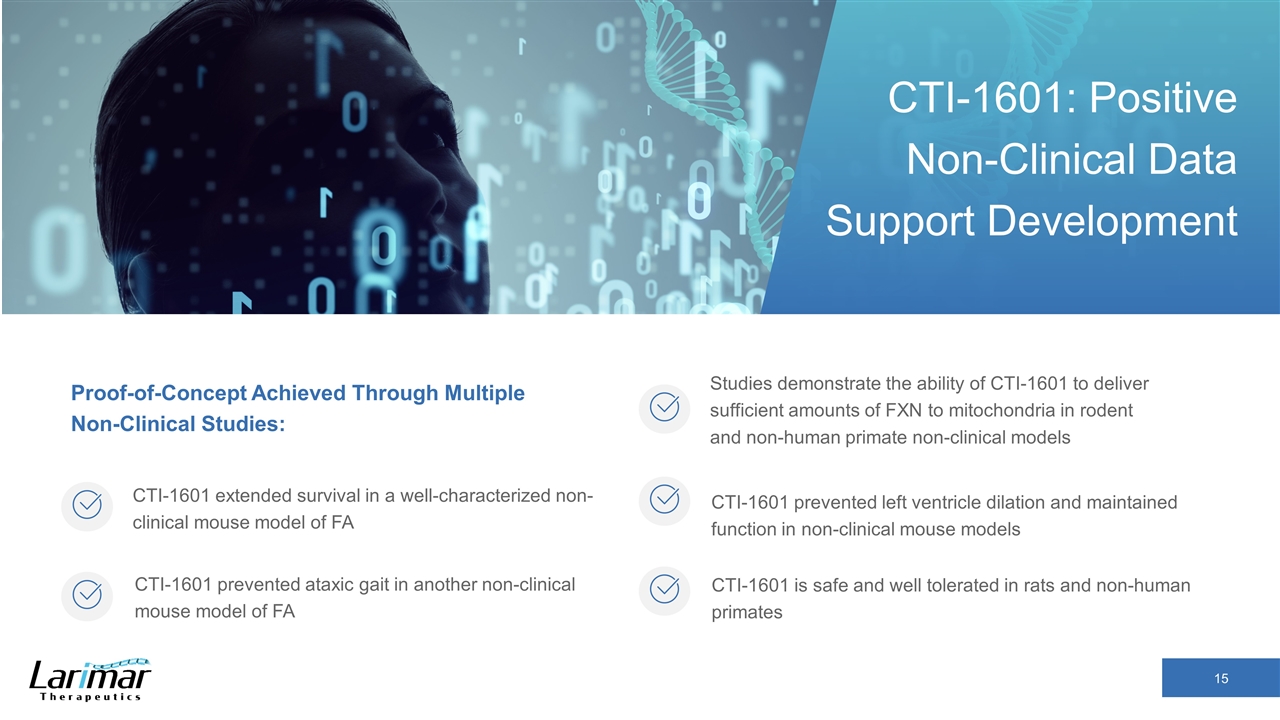
CTI-1601: Positive Non-Clinical Data Support Development CTI-1601 extended survival in a well-characterized non-clinical mouse model of FA CTI-1601 prevented left ventricle dilation and maintained function in non-clinical mouse models CTI-1601 prevented ataxic gait in another non-clinical mouse model of FA Studies demonstrate the ability of CTI-1601 to deliver sufficient amounts of FXN to mitochondria in rodent and non-human primate non-clinical models CTI-1601 is safe and well tolerated in rats and non-human primates Proof-of-Concept Achieved Through Multiple Non-Clinical Studies:
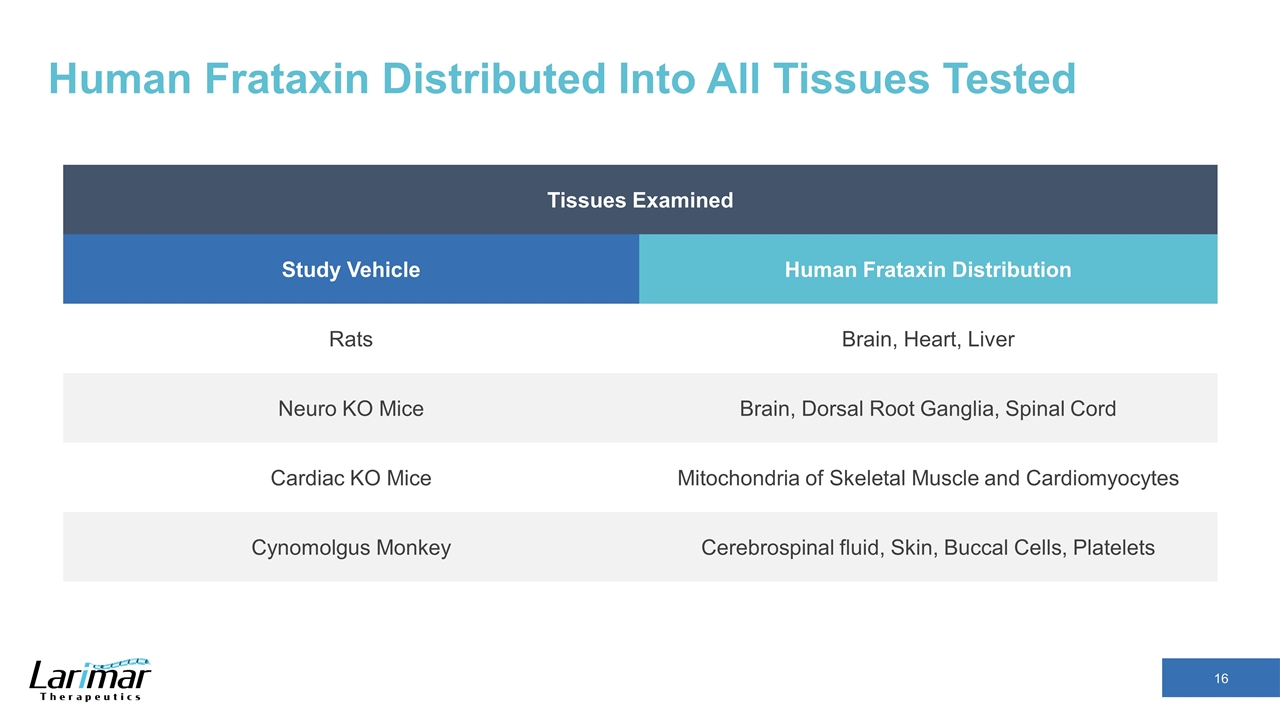
Human Frataxin Distributed Into All Tissues Tested Tissues Examined Study Vehicle Human Frataxin Distribution Rats Brain, Heart, Liver Neuro KO Mice Brain, Dorsal Root Ganglia, Spinal Cord Cardiac KO Mice Mitochondria of Skeletal Muscle and Cardiomyocytes Cynomolgus Monkey Cerebrospinal fluid, Skin, Buccal Cells, Platelets
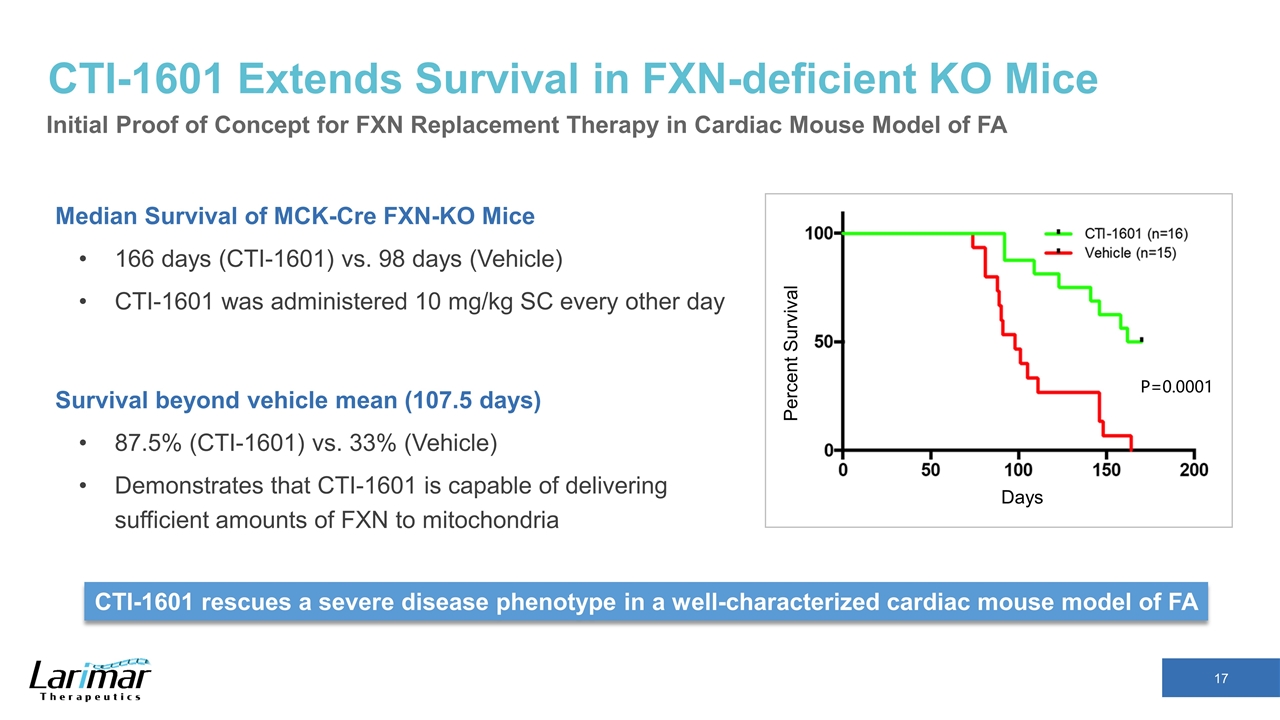
CTI-1601 Extends Survival in FXN-deficient KO Mice Median Survival of MCK-Cre FXN-KO Mice 166 days (CTI-1601) vs. 98 days (Vehicle) CTI-1601 was administered 10 mg/kg SC every other day Survival beyond vehicle mean (107.5 days) 87.5% (CTI-1601) vs. 33% (Vehicle) Demonstrates that CTI-1601 is capable of delivering sufficient amounts of FXN to mitochondria Days Percent Survival CTI-1601 rescues a severe disease phenotype in a well-characterized cardiac mouse model of FA P=0.0001 Initial Proof of Concept for FXN Replacement Therapy in Cardiac Mouse Model of FA
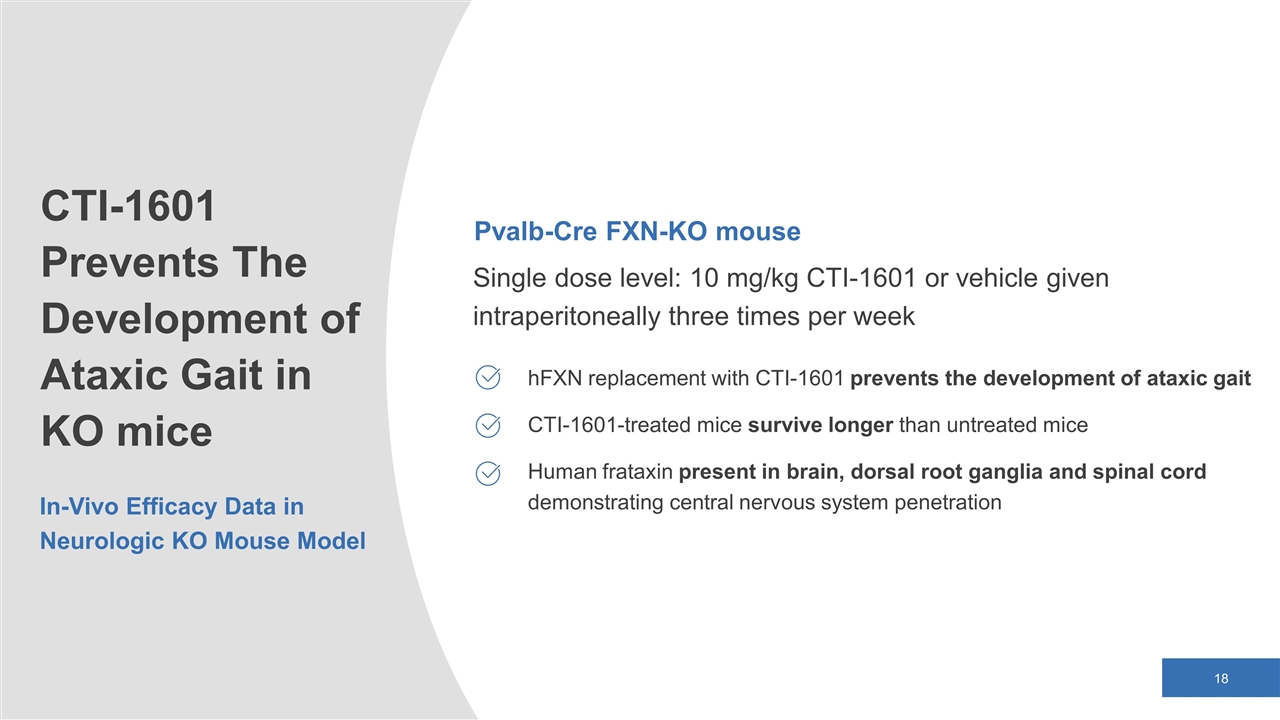
Pvalb-Cre FXN-KO mouse Single dose level: 10 mg/kg CTI-1601 or vehicle given intraperitoneally three times per week hFXN replacement with CTI-1601 prevents the development of ataxic gait CTI-1601-treated mice survive longer than untreated mice Human frataxin present in brain, dorsal root ganglia and spinal cord demonstrating central nervous system penetration CTI-1601 Prevents The Development of Ataxic Gait in KO mice In-Vivo Efficacy Data in Neurologic KO Mouse Model

CTI-1601 Delivers hFXN to Mitochondria in KO Mice hFXN concentration within mitochondria increases in a dose-dependent manner Given subcutaneously, CTI-1601 functionally replaces hFXN in mitochondria of KO mice *Succinate dehydrogenase (SDH) activity, which is indicative of mitochondrial function, increases in a dose-dependent manner after administration of CTI-1601; activity plateaus at 30 mg/kg and is equivalent to activity in wild type animals Demonstrated normalization of gene expression in cardiac tissue MPK = mg/kg MPK = mg/kg Normalized Mitochondrial FXN (Heart) Normalized SDH Activity (Muscle)
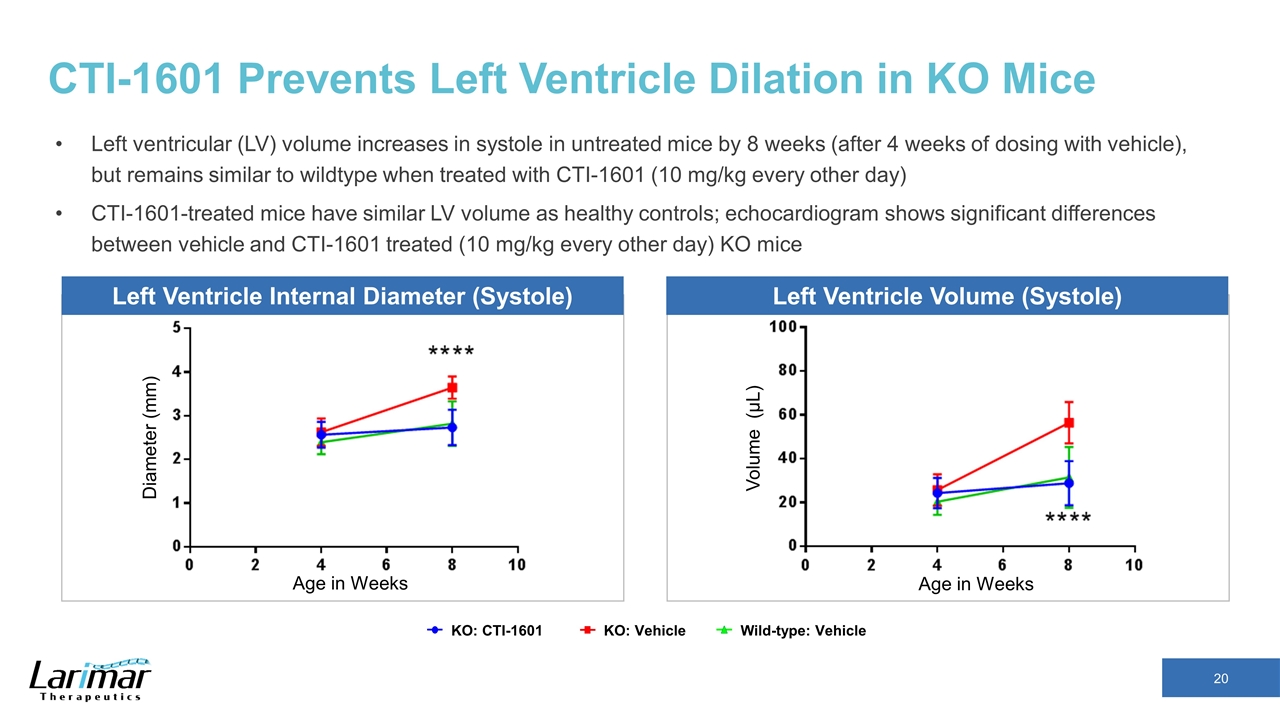
CTI-1601 Prevents Left Ventricle Dilation in KO Mice Left ventricular (LV) volume increases in systole in untreated mice by 8 weeks (after 4 weeks of dosing with vehicle), but remains similar to wildtype when treated with CTI-1601 (10 mg/kg every other day) CTI-1601-treated mice have similar LV volume as healthy controls; echocardiogram shows significant differences between vehicle and CTI-1601 treated (10 mg/kg every other day) KO mice Diameter (mm) Age in Weeks Age in Weeks Volume (μL) KO: CTI-1601 Wild-type: Vehicle KO: Vehicle Left Ventricle Internal Diameter (Systole) Left Ventricle Volume (Systole)
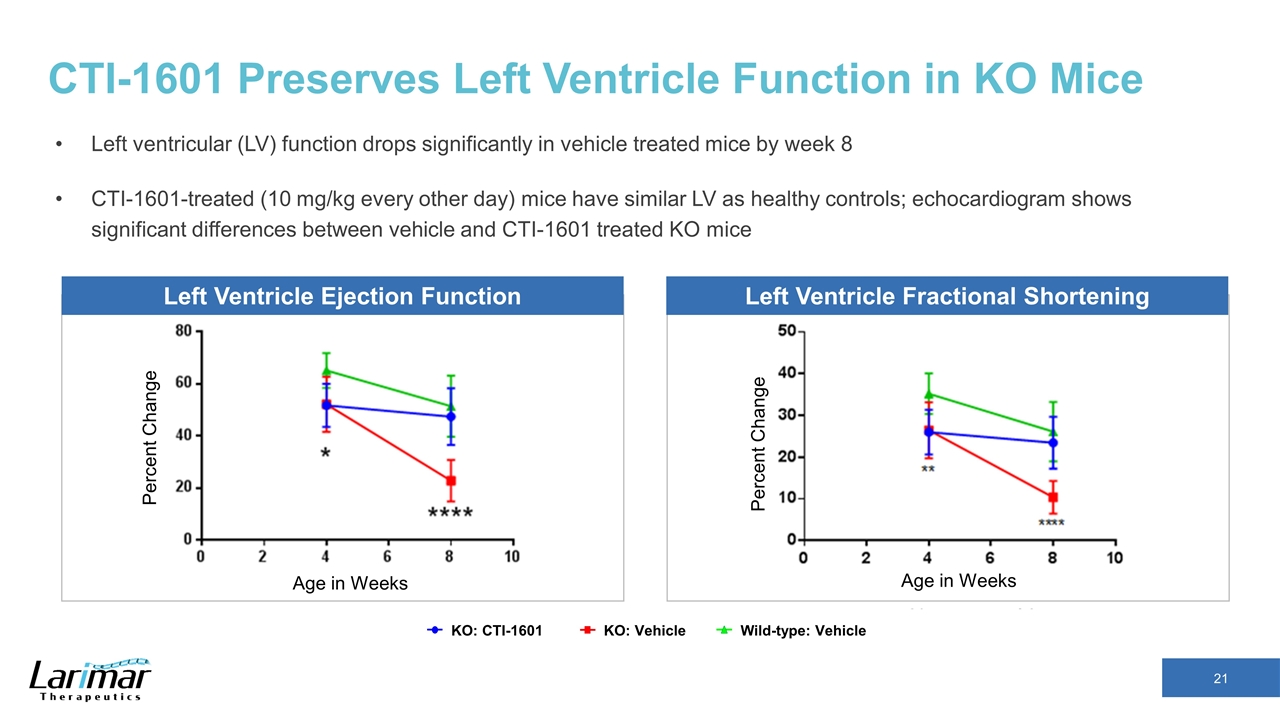
CTI-1601 Preserves Left Ventricle Function in KO Mice Left ventricular (LV) function drops significantly in vehicle treated mice by week 8 CTI-1601-treated (10 mg/kg every other day) mice have similar LV as healthy controls; echocardiogram shows significant differences between vehicle and CTI-1601 treated KO mice Percent Change Age in Weeks KO: CTI-1601 Wild-type: Vehicle KO: Vehicle Left Ventricle Ejection Function Left Ventricle Fractional Shortening Percent Change Age in Weeks
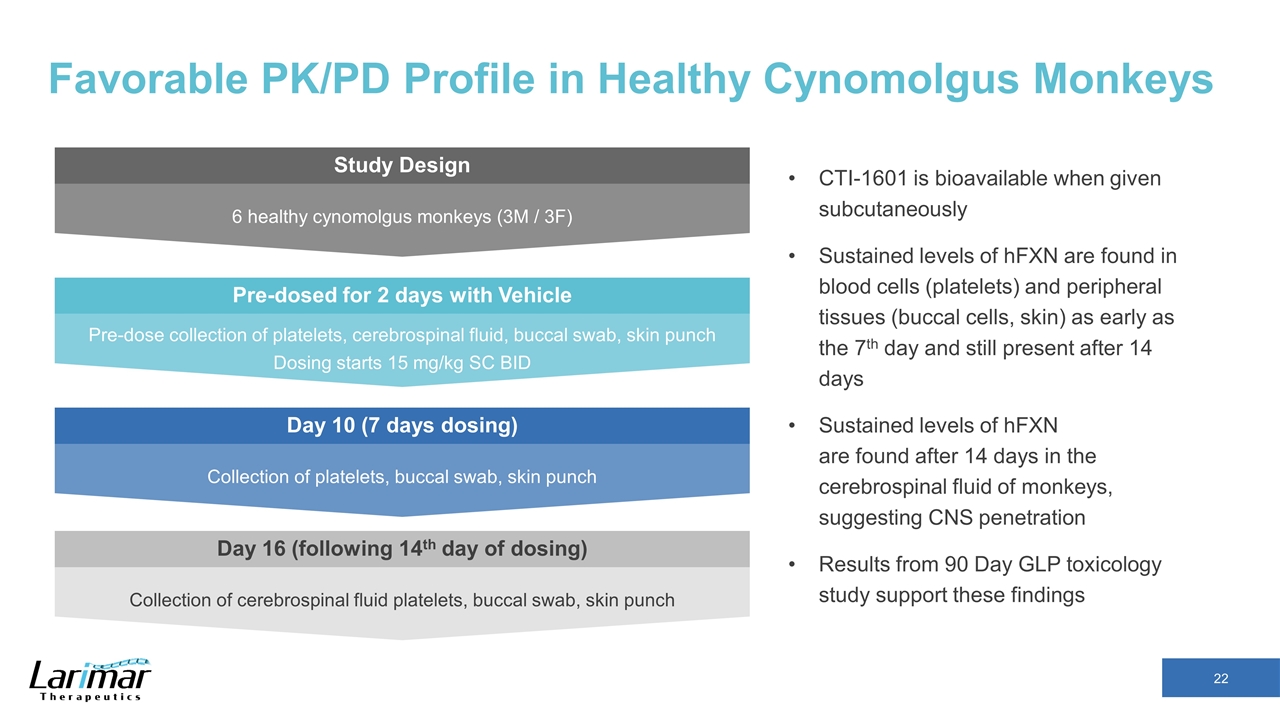
Favorable PK/PD Profile in Healthy Cynomolgus Monkeys CTI-1601 is bioavailable when given subcutaneously Sustained levels of hFXN are found in blood cells (platelets) and peripheral tissues (buccal cells, skin) as early as the 7th day and still present after 14 days Sustained levels of hFXN are found after 14 days in the cerebrospinal fluid of monkeys, suggesting CNS penetration Results from 90 Day GLP toxicology study support these findings Study Design 6 healthy cynomolgus monkeys (3M / 3F) Pre-dosed for 2 days with Vehicle Pre-dose collection of platelets, cerebrospinal fluid, buccal swab, skin punch Dosing starts 15 mg/kg SC BID Day 10 (7 days dosing) Collection of platelets, buccal swab, skin punch Day 16 (following 14th day of dosing) Collection of cerebrospinal fluid platelets, buccal swab, skin punch
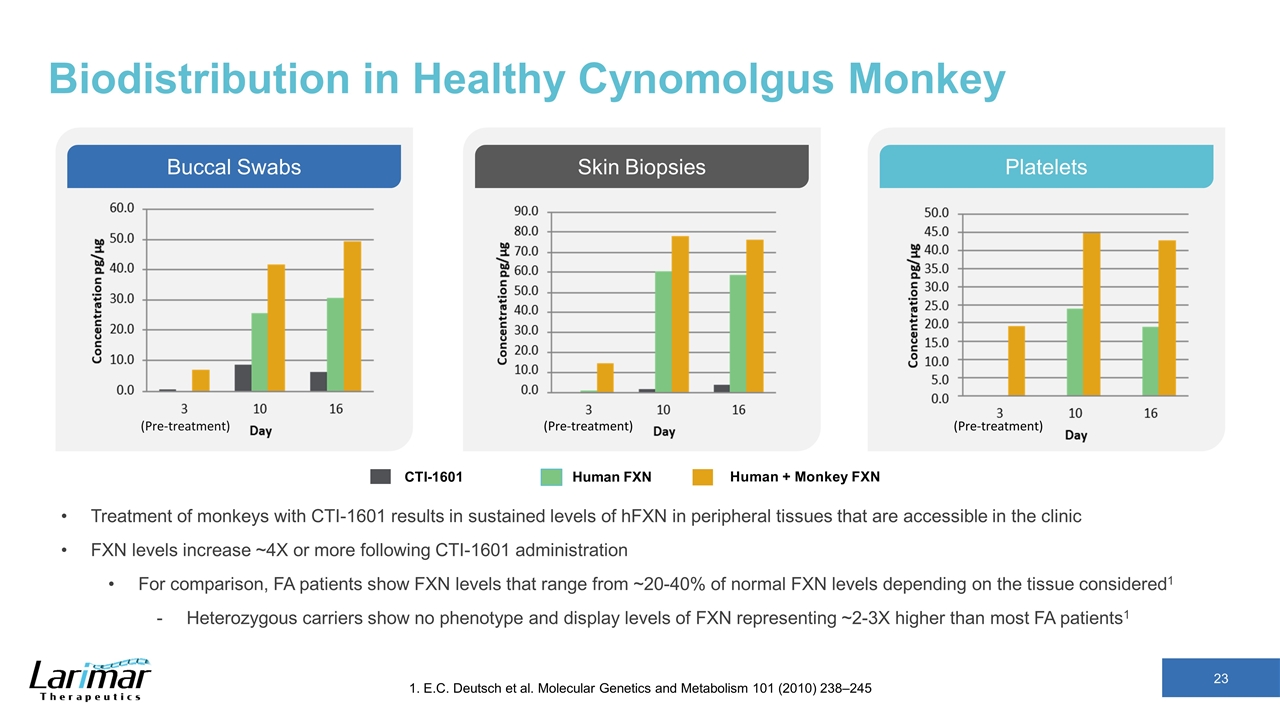
Biodistribution in Healthy Cynomolgus Monkey Treatment of monkeys with CTI-1601 results in sustained levels of hFXN in peripheral tissues that are accessible in the clinic FXN levels increase ~4X or more following CTI-1601 administration For comparison, FA patients show FXN levels that range from ~20-40% of normal FXN levels depending on the tissue considered1 Heterozygous carriers show no phenotype and display levels of FXN representing ~2-3X higher than most FA patients1 Buccal Swabs Skin Biopsies Platelets CTI-1601 Human FXN Human + Monkey FXN (Pre-treatment) (Pre-treatment) (Pre-treatment) 1. E.C. Deutsch et al. Molecular Genetics and Metabolism 101 (2010) 238–245
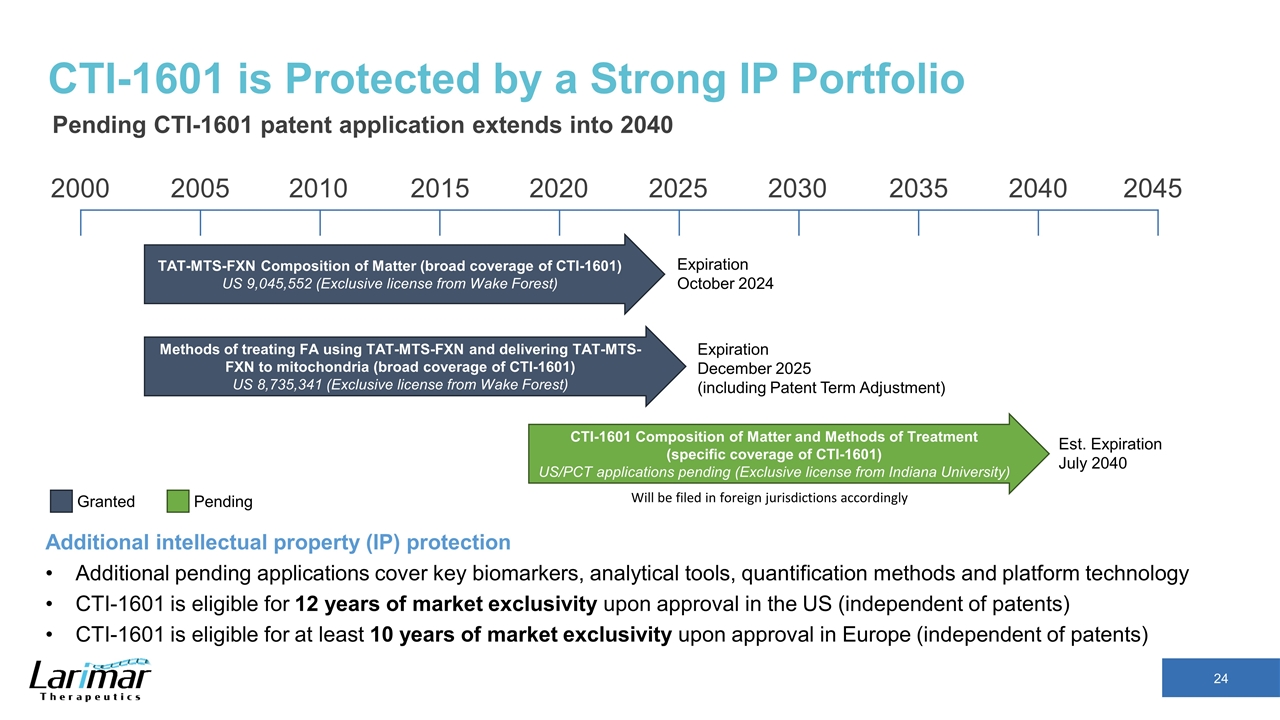
CTI-1601 is Protected by a Strong IP Portfolio 2005 2010 2020 2025 2030 2035 2040 2045 2000 Pending Granted TAT-MTS-FXN Composition of Matter (broad coverage of CTI-1601) US 9,045,552 (Exclusive license from Wake Forest) Expiration October 2024 CTI-1601 Composition of Matter and Methods of Treatment (specific coverage of CTI-1601) US/PCT applications pending (Exclusive license from Indiana University) Est. Expiration July 2040 Will be filed in foreign jurisdictions accordingly 2015 Methods of treating FA using TAT-MTS-FXN and delivering TAT-MTS-FXN to mitochondria (broad coverage of CTI-1601) US 8,735,341 (Exclusive license from Wake Forest) Expiration December 2025 (including Patent Term Adjustment) Pending CTI-1601 patent application extends into 2040 Additional intellectual property (IP) protection Additional pending applications cover key biomarkers, analytical tools, quantification methods and platform technology CTI-1601 is eligible for 12 years of market exclusivity upon approval in the US (independent of patents) CTI-1601 is eligible for at least 10 years of market exclusivity upon approval in Europe (independent of patents)
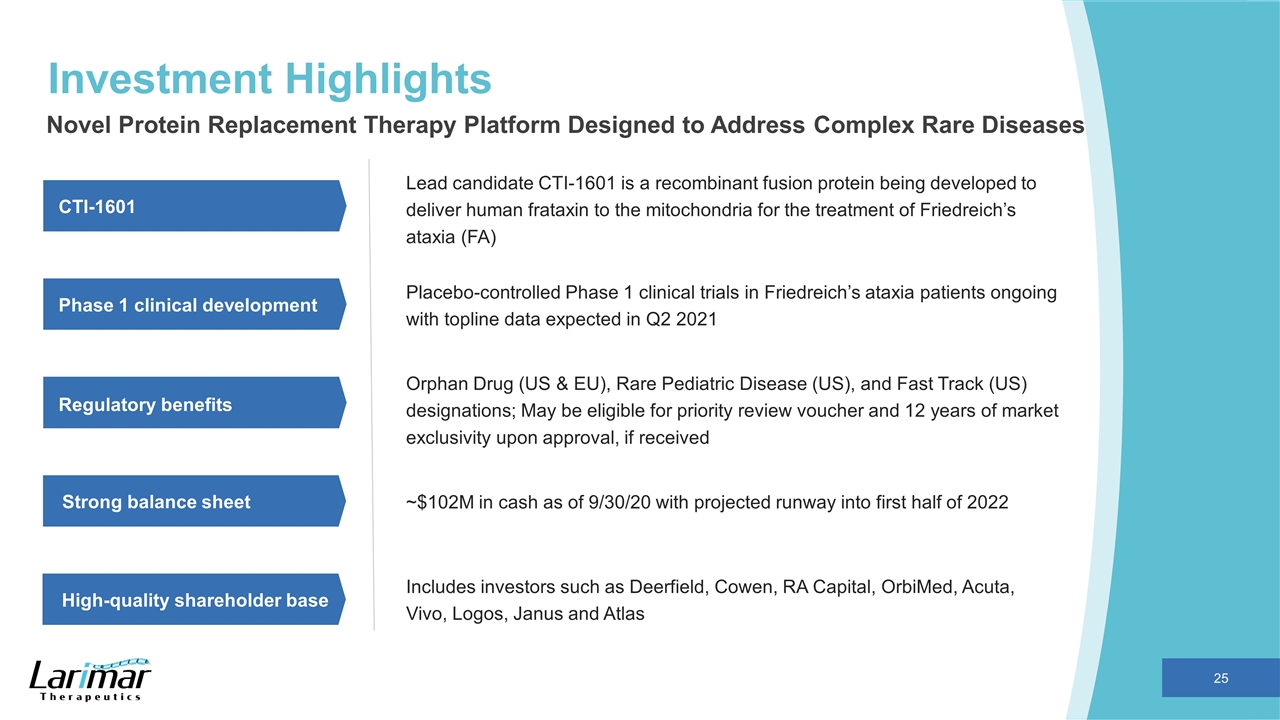
Lead candidate CTI-1601 is a recombinant fusion protein being developed to deliver human frataxin to the mitochondria for the treatment of Friedreich’s ataxia (FA) Investment Highlights Regulatory benefits Strong balance sheet Placebo-controlled Phase 1 clinical trials in Friedreich’s ataxia patients ongoing with topline data expected in Q2 2021 Orphan Drug (US & EU), Rare Pediatric Disease (US), and Fast Track (US) designations; May be eligible for priority review voucher and 12 years of market exclusivity upon approval, if received ~$102M in cash as of 9/30/20 with projected runway into first half of 2022 Phase 1 clinical development CTI-1601 Novel Protein Replacement Therapy Platform Designed to Address Complex Rare Diseases High-quality shareholder base Includes investors such as Deerfield, Cowen, RA Capital, OrbiMed, Acuta, Vivo, Logos, Janus and Atlas

THANK YOU Larimar Therapeutics Corporate Presentation

Leadership Team Carole Ben-Maimon, MD Chief Executive Officer Nancy M. Ruiz, MD, FACP, FIDSA Chief Medical Officer John Berman, CPA VP Finance & Operations Jennifer Johansson, JD VP Regulatory Affairs & Counsel David Bettoun, PhD VP Discovery & Non-clinical R&D Noreen Scherer VP, Clinical Operations Michael Celano Chief Financial Officer Keith E. Lynch, Jr. VP, Manufacturing and Supply Chain Francis Michael Conway Vice President Controller
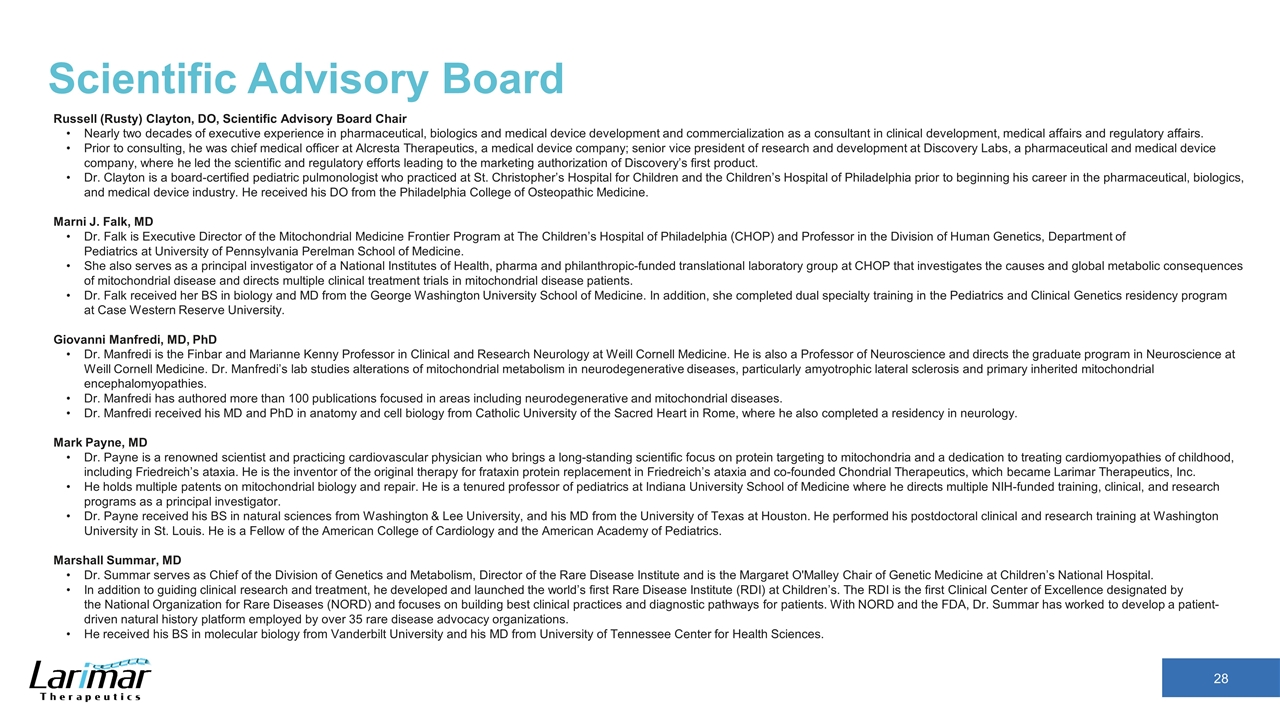
Scientific Advisory Board Russell (Rusty) Clayton, DO, Scientific Advisory Board Chair Nearly two decades of executive experience in pharmaceutical, biologics and medical device development and commercialization as a consultant in clinical development, medical affairs and regulatory affairs. Prior to consulting, he was chief medical officer at Alcresta Therapeutics, a medical device company; senior vice president of research and development at Discovery Labs, a pharmaceutical and medical device company, where he led the scientific and regulatory efforts leading to the marketing authorization of Discovery’s first product. Dr. Clayton is a board-certified pediatric pulmonologist who practiced at St. Christopher’s Hospital for Children and the Children’s Hospital of Philadelphia prior to beginning his career in the pharmaceutical, biologics, and medical device industry. He received his DO from the Philadelphia College of Osteopathic Medicine. Marni J. Falk, MD Dr. Falk is Executive Director of the Mitochondrial Medicine Frontier Program at The Children’s Hospital of Philadelphia (CHOP) and Professor in the Division of Human Genetics, Department of Pediatrics at University of Pennsylvania Perelman School of Medicine. She also serves as a principal investigator of a National Institutes of Health, pharma and philanthropic-funded translational laboratory group at CHOP that investigates the causes and global metabolic consequences of mitochondrial disease and directs multiple clinical treatment trials in mitochondrial disease patients. Dr. Falk received her BS in biology and MD from the George Washington University School of Medicine. In addition, she completed dual specialty training in the Pediatrics and Clinical Genetics residency program at Case Western Reserve University. Giovanni Manfredi, MD, PhD Dr. Manfredi is the Finbar and Marianne Kenny Professor in Clinical and Research Neurology at Weill Cornell Medicine. He is also a Professor of Neuroscience and directs the graduate program in Neuroscience at Weill Cornell Medicine. Dr. Manfredi’s lab studies alterations of mitochondrial metabolism in neurodegenerative diseases, particularly amyotrophic lateral sclerosis and primary inherited mitochondrial encephalomyopathies. Dr. Manfredi has authored more than 100 publications focused in areas including neurodegenerative and mitochondrial diseases. Dr. Manfredi received his MD and PhD in anatomy and cell biology from Catholic University of the Sacred Heart in Rome, where he also completed a residency in neurology. Mark Payne, MD Dr. Payne is a renowned scientist and practicing cardiovascular physician who brings a long-standing scientific focus on protein targeting to mitochondria and a dedication to treating cardiomyopathies of childhood, including Friedreich’s ataxia. He is the inventor of the original therapy for frataxin protein replacement in Friedreich’s ataxia and co-founded Chondrial Therapeutics, which became Larimar Therapeutics, Inc. He holds multiple patents on mitochondrial biology and repair. He is a tenured professor of pediatrics at Indiana University School of Medicine where he directs multiple NIH-funded training, clinical, and research programs as a principal investigator. Dr. Payne received his BS in natural sciences from Washington & Lee University, and his MD from the University of Texas at Houston. He performed his postdoctoral clinical and research training at Washington University in St. Louis. He is a Fellow of the American College of Cardiology and the American Academy of Pediatrics. Marshall Summar, MD Dr. Summar serves as Chief of the Division of Genetics and Metabolism, Director of the Rare Disease Institute and is the Margaret O'Malley Chair of Genetic Medicine at Children’s National Hospital. In addition to guiding clinical research and treatment, he developed and launched the world’s first Rare Disease Institute (RDI) at Children’s. The RDI is the first Clinical Center of Excellence designated by the National Organization for Rare Diseases (NORD) and focuses on building best clinical practices and diagnostic pathways for patients. With NORD and the FDA, Dr. Summar has worked to develop a patient-driven natural history platform employed by over 35 rare disease advocacy organizations. He received his BS in molecular biology from Vanderbilt University and his MD from University of Tennessee Center for Health Sciences.
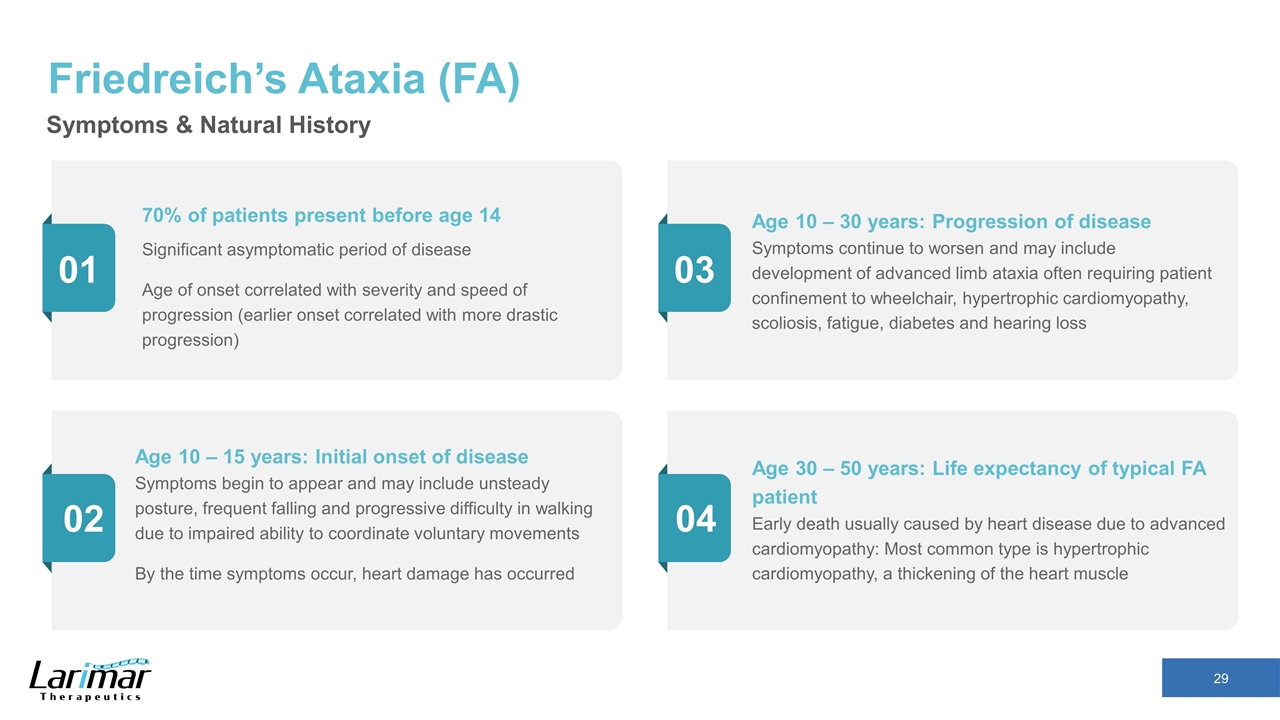
Friedreich’s Ataxia (FA) Symptoms & Natural History 70% of patients present before age 14 Significant asymptomatic period of disease Age of onset correlated with severity and speed of progression (earlier onset correlated with more drastic progression) Age 10 – 30 years: Progression of disease Symptoms continue to worsen and may include development of advanced limb ataxia often requiring patient confinement to wheelchair, hypertrophic cardiomyopathy, scoliosis, fatigue, diabetes and hearing loss Age 10 – 15 years: Initial onset of disease Symptoms begin to appear and may include unsteady posture, frequent falling and progressive difficulty in walking due to impaired ability to coordinate voluntary movements By the time symptoms occur, heart damage has occurred Age 30 – 50 years: Life expectancy of typical FA patient Early death usually caused by heart disease due to advanced cardiomyopathy: Most common type is hypertrophic cardiomyopathy, a thickening of the heart muscle 01 02 03 04
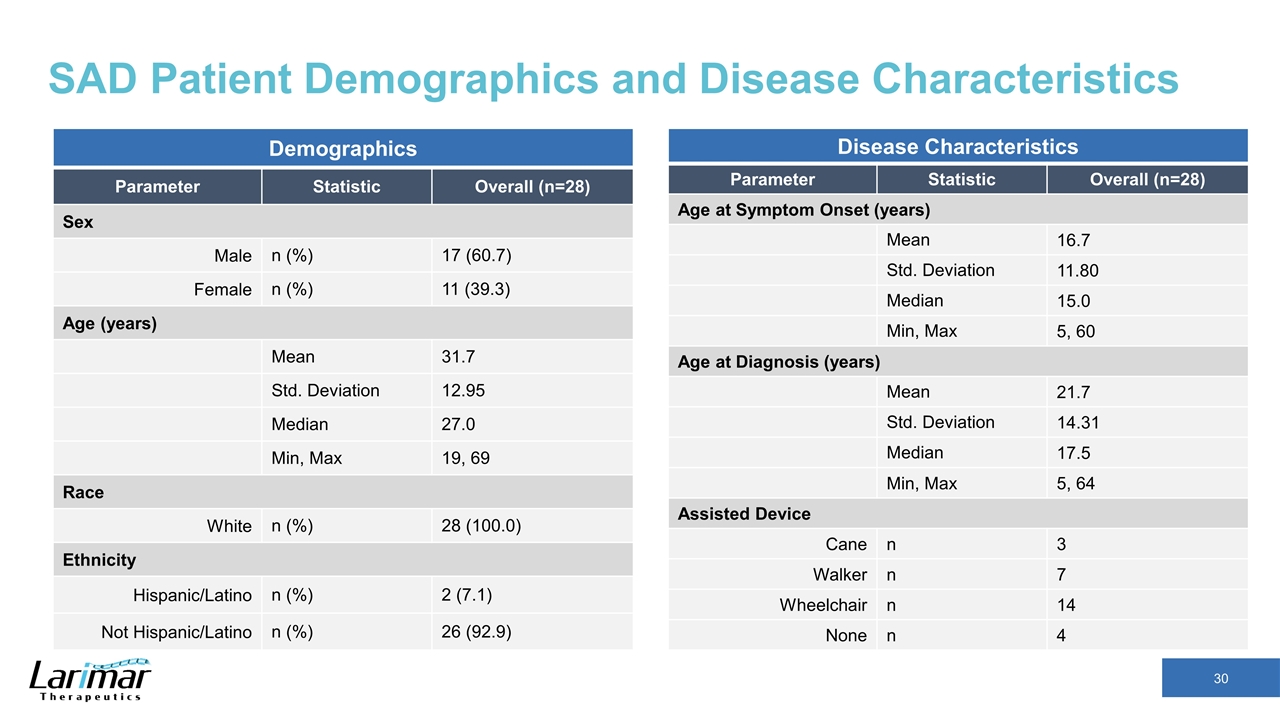
SAD Patient Demographics and Disease Characteristics Demographics Parameter Statistic Overall (n=28) Sex Male n (%) 17 (60.7) Female n (%) 11 (39.3) Age (years) Mean 31.7 Std. Deviation 12.95 Median 27.0 Min, Max 19, 69 Race White n (%) 28 (100.0) Ethnicity Hispanic/Latino n (%) 2 (7.1) Not Hispanic/Latino n (%) 26 (92.9) Disease Characteristics Parameter Statistic Overall (n=28) Age at Symptom Onset (years) Mean 16.7 Std. Deviation 11.80 Median 15.0 Min, Max 5, 60 Age at Diagnosis (years) Mean 21.7 Std. Deviation 14.31 Median 17.5 Min, Max 5, 64 Assisted Device Cane n 3 Walker n 7 Wheelchair n 14 None n 4
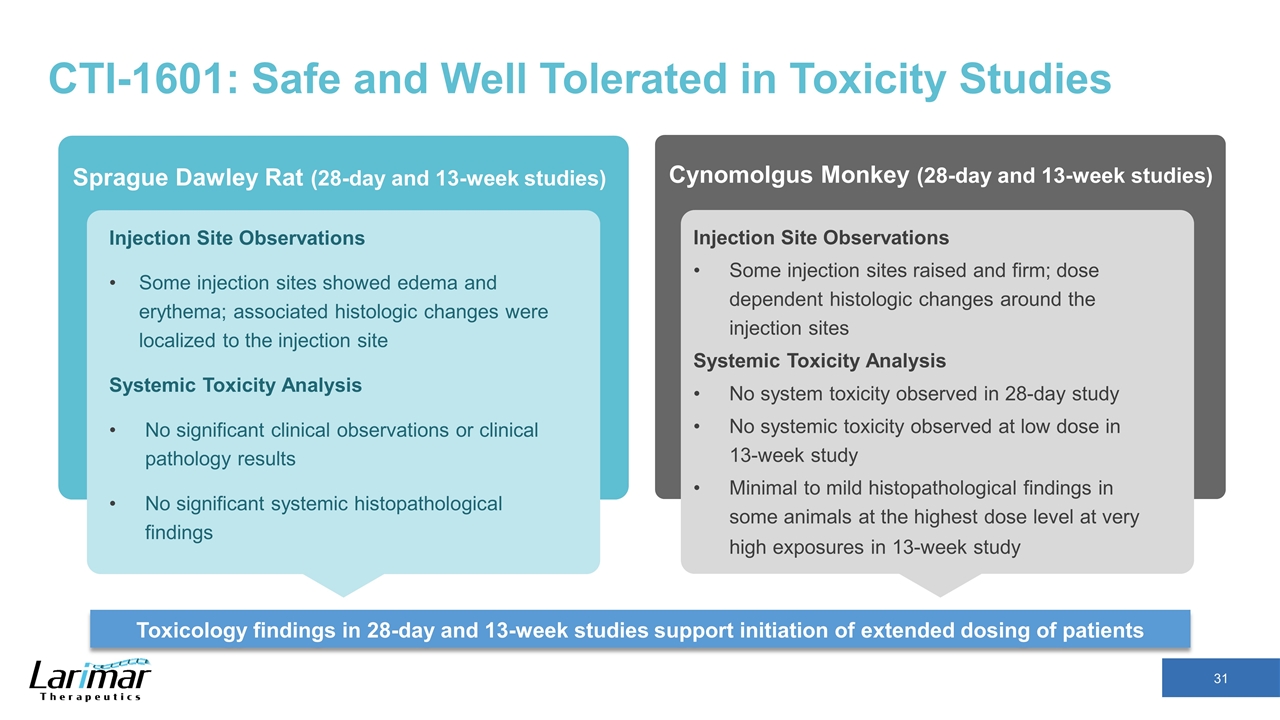
CTI-1601: Safe and Well Tolerated in Toxicity Studies Toxicology findings in 28-day and 13-week studies support initiation of extended dosing of patients Sprague Dawley Rat (28-day and 13-week studies) Cynomolgus Monkey (28-day and 13-week studies) Injection Site Observations Some injection sites showed edema and erythema; associated histologic changes were localized to the injection site Systemic Toxicity Analysis No significant clinical observations or clinical pathology results No significant systemic histopathological findings Injection Site Observations Some injection sites raised and firm; dose dependent histologic changes around the injection sites Systemic Toxicity Analysis No system toxicity observed in 28-day study No systemic toxicity observed at low dose in 13-week study Minimal to mild histopathological findings in some animals at the highest dose level at very high exposures in 13-week study






























